Urban Cultures through the Eyes of Rimpa and Impressionism
Before the Impressionism movement stirred the evolution of art across Europe in the late 1800s, a flourishing art school in Japan started to train gifted Japanese artists from the 17th century. The Rimpa School, whose name derived from the painter Ogata Korin’s (1658-1716) and the word “ha” (meaning school), was a highly sophisticated style of decorative art mainly focusing on paintings, lacquer ware, ceramics, and calligraphy that blossomed in the Edo period.
The Artizon Museum in Kyobashi is presenting an extensive exhibition, “Rimpa and Impressionism: Arts Produced by Urban Cultures, East and West” until the 24th of January next year. It encompasses the significant works of the acclaimed Rimpa artists Koetsu Honami, Sotatsu Tawaraya, Korin Ogata, Kenzan Ogata, Hoitsu Sakai, Kiitsu Suzuki, Koson Ikeda, Shiko Watanabe, and Hochu Nakamura, alongside notable Impressionist and Post-Impressionist masters Édouard Manet, Claude Monet, Edgar Degas, Pierre-Auguste Renoir, Camille Pissarro, Paul Cézanne, Vincent Van Gogh, Paul Gauguin, Maurice Utrillo, Camille Corot, Alfred Sisley, Paul Signac, Auguste Rodin, Émile-Antoine Bourdelle, Constantin Guys, Berthe Morisot, Mary Cassatt, Gustave Caillebotte, Eva Gonzalès, and Henri Fantin-Latour. The exhibition looks at the two art movements’ profound impact on the urban cultures both in Japan and Europe.

Although Rimpa and Impressionism evolved during divergent periods, the exhibition attempts to extract the similarities and differences in their artistic concepts by studying particular themes, such as nature (flowers, plants, water), space, still lifes, cityscapes, and objects like fans. Positioning the Japanese artworks side by side with the European masterpieces gives the viewer a comparative outlook on 17th–18th century Japanese art. After all, Japan’s isolation from the world for about 200 years offered artists time to hone their instinctive skills to the highest level, and by the time the country opened its doors to the West in 1853, the suppressed curiosity surrounding Japan’s development of their arts and crafts was inflated to the extent that it gave rise to the Japonisme that infused the East and the West.

On the Impressionism side, no other master did more than Claude Monet to capture nature in its rawness and vibrancy. One of his most endearing paintings that steals the spotlight in this exhibition is Twilight, Venice (c. 1908). Monet applies spirited blues, reds, oranges, and yellows to illustrate the sunset that glows across the Venetian lagoon. The colorful reflection on the beautifully textured rippling waters and the dark shadow of the church stand out radiantly against the powerful light. This is one piece that you can stare at incessantly as it draws you to its spell. In contrast to Ogata’s nature, which is more refined in its minimal lines, strokes, and color choices, Monet’s sceneries seem to spread the joy of color and texture throughout the canvas. His Water Lily Pond (1907) likewise captures dream-like reflections of willow trees that seem to fill up a fantasy-like space.
Exquisite scenery on Japanese fans are also presented. Six fan paintings by Sotatsu Tawaraya comprising Scene from the Tale of the Hogen-Heiji Battles (17th century) illustrate tales from two war narratives, The Tale of Hogen (1156), and The Tale of the Heiji (1159–1160). Each picture displays scenes with warlords on horses in battle or townsfolk surrounded by nature. Surprisingly, Édouard Manet attempts to imbue an Eastern motif on a Japanese fan in his Chrysanthemums (c. 1881). The chrysanthemum is, of course, the Imperial emblem of Japan, and Manet has chosen pink and white varieties set asymmetrically against an abstract moss-green finish.

The portrayal of two art cities (Kyoto in the East and Paris the West) from different timelines delivers an interesting angle, as well. Certainly not to be missed is the enormous Views in and around the City of Kyoto (17th century, Edo period), a pair of six-panel screens at the front of the entrance of the exhibition. Measuring 155.5 cm × 361.4 cm each, the screen paintings narrate historic events in Kyoto from a Gion Festival, another procession at Nijo Castle, to daily customs during the Edo period, all painted in remarkable detail illustrating temples, houses, bridges, mountains, horses, and people doing various activities. Meanwhile, Camille Pissarro’s Le Pont Neuf, (1902) captures the Parisian life from Paris’ oldest bridge, Pont Neuf. With patches of small brushstrokes, Pissarro reveals travelers in horse carriages and people strolling or sitting by the bridge, with the broad perspective of the Parisian buildings behind.

Both the Rimpa School and Impressionist artists developed their skills during aristocratic periods in two far-distant parts of the world. Through their elaborate and highly aesthetic techniques, we are able to understand in more depth the refinement and sophistication of both Eastern and Western urban cultures before the 20th century.
Alma Reyes
Alma Reyes



